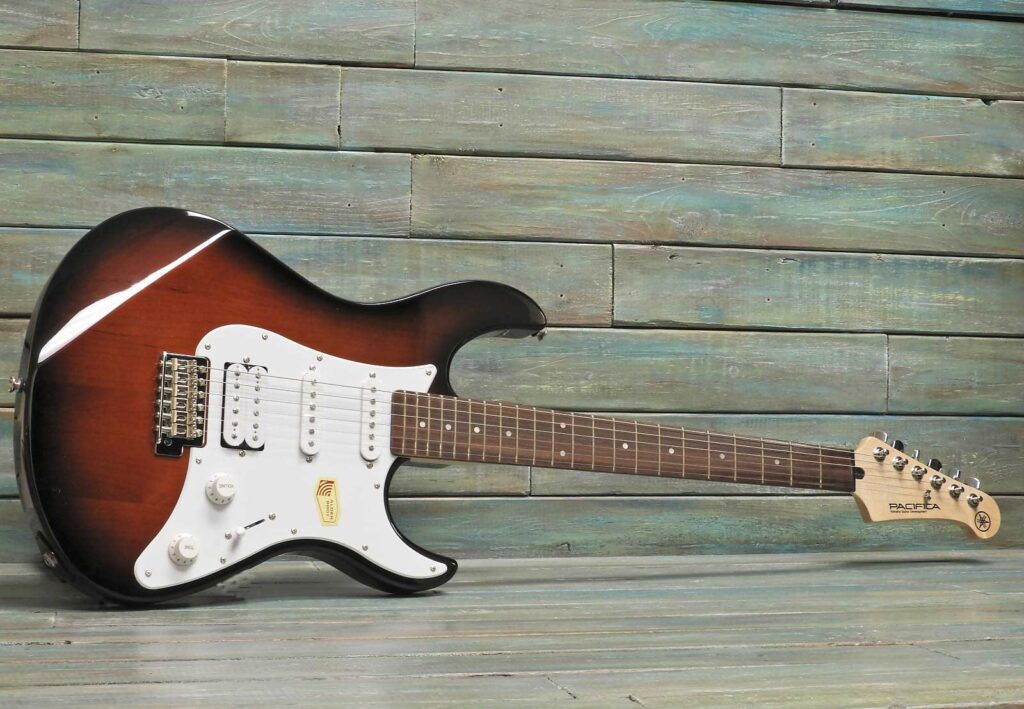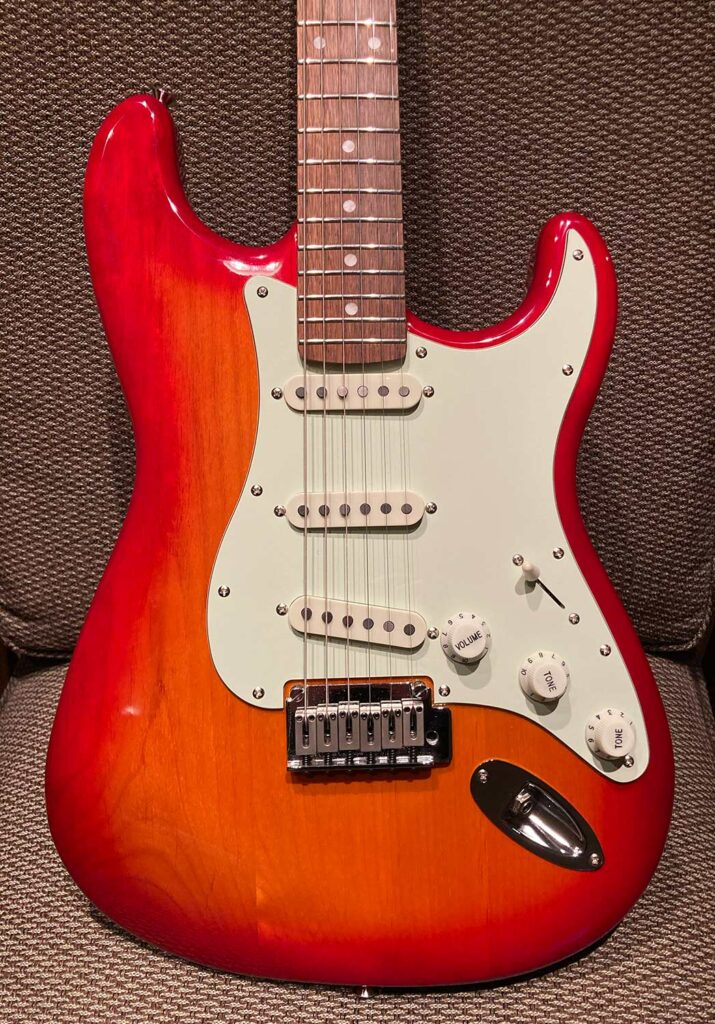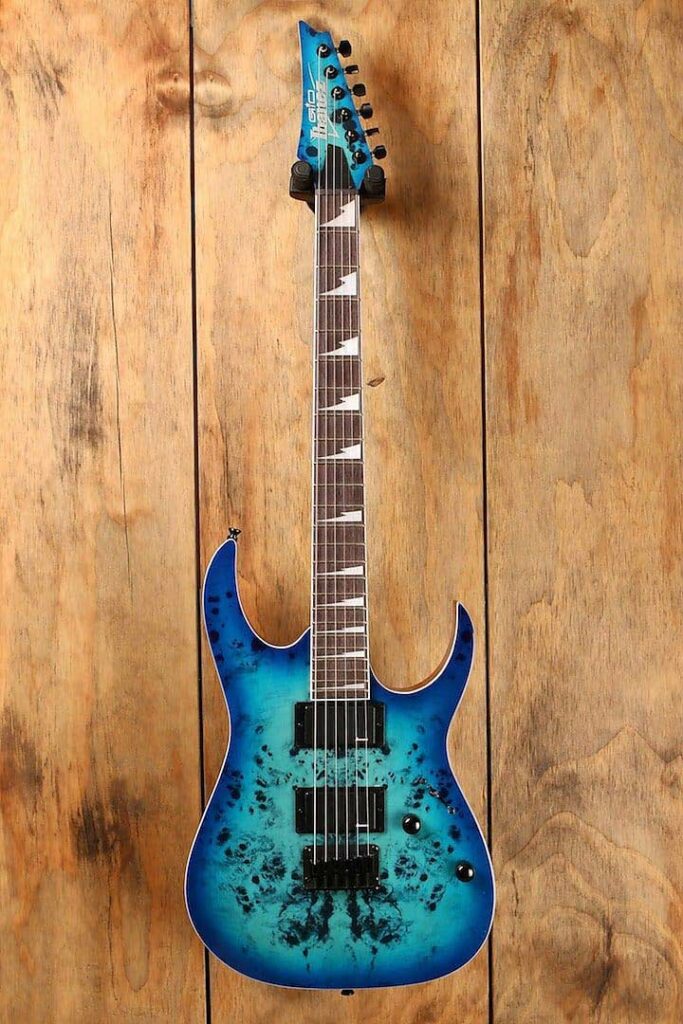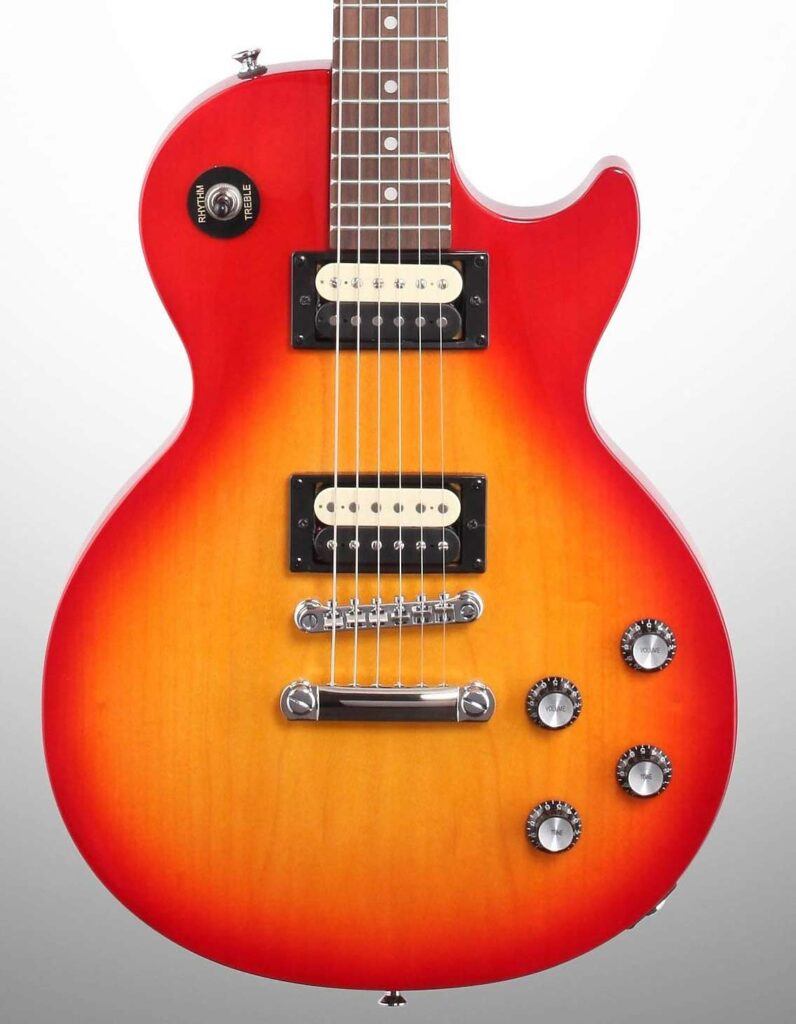Guitar River is reader-supported. We may earn a commission when you make a purchase using the links on our site.
Learn more.
Best electric guitars under $300: Our Top 5 Picks

Although electric guitar prices seem to be rapidly increasing, between $200 and $300 is still a good price range for an electric guitar. Within this budget, you can get a solid beginner guitar with room to grow. Keep reading to see our top picks.
Guitars in this category are going to be made overseas, usually in China. The pickups and other components may be good candidates for upgrades later on. Generally, the body of the guitar will be fine, as well as the neck. But the frets may wear faster than on more expensive guitars.
Even on a budget you can find something worth your while. And if you consider used electric guitars, you may be able to get a higher-quality instrument at a discount. With that, we’ve compiled our top-five list for guitars in this price range.
1. Pacifica 112J
The Pacifica is one of my favorite guitar models for versatility and performance. The humbucker-single-single (HSS) pickup combination gives you a wide range of tones. The fretboard radius is a comfortable 13 and 3/4 inches. it’s not as round as a traditional Fender or Squier radius of 9.5 inches, and it’s not as flat as an Ibanez.
The 112J pickups are capable, but as you become a better player, you may want to upgrade the pickups, or trade it in for the next model Pacifica. The pickups are ceramic, which may be a drawback to some. However, they will be fine for most beginners.
On the 100 series Pacificas, the hardware is a basic, unbranded variety. On the 300 and 600 series, you get brand-name hardware, such as Grover tuners and a Wilkinson bridge. The pickups are upgraded in the 600 series to Seymour Duncan pickups.

Even if the hardware and pickups are low-end on the 100 series, this model shares the same maple neck, alder body, and rosewood fretboard as the higher-range models.
Upgrading to the 112V or 112VM, you have the addition of a push-pull coil split on the humbucker. And the 112VM offers a maple fretboard.
There is a choice of finishes, from a natural stain and a traditional violin burst, to vibrant solid colors. I think the Yamaha Pacifica is still one of the best value guitars out there, and it’s hard to match.
2. Squier Affinity Series
It’s no surprise that Squier makes an appearance on this list. The Affinity series of guitars ranges between $200 and $300. These are great starter guitars. And some, such as the Telecaster Deluxe, offer a bit more style and tonal options than you normally find in this price range.
If you want the classic Strat or Tele look and sound, you cannot go wrong with the Affinity series. The pickups in this line are ceramic. You will need to jump up to the classic vibe series if you want alnico pickups. (See our blog post for a little more information about the difference between alnico and ceramic pickups.)
Affinity Series Telecaster
The Squier Affinity Series Tele is an excellent, no-nonsense guitar, well-suited to a beginner. The poplar body and maple neck combination will generate bright and crisp tones, perfect for rock, blues, and country.
The string-through body and classic bridge saddle design offer tuning stability and sustain. Beginners will find this helpful, and won’t be distracted by a tremolo system.
As with other models in the Affinity lineup, the pickups are ceramic. The Tele has the traditional three-way switch and two single-coil pickups. Along with the Strat, the fingerboard radius is 9.5 inches.
Both the Affinity Tele and the Strat models have an unfinished, satin neck. This makes moving around the neck easier as your hand doesn’t stick to the unfinished wood.
One nice feature found on the Affinity Teles is tuning machines with split shafts. Basically, this means restringing the guitar is easier. While not locking tuners, this is an upgrade from the standard tuning machines.
For more tonal options, check out the Affinity Series Telecaster Deluxe. I prefer the styling on this guitar, as well as the additional tone controls. Unless you want the Tele single-coil sound, I’d recommend the Deluxe version with two humbuckers, and additional tone and volume controls.

Affinity Series Stratocaster
The Affinity Series Strat offers the traditional Strat stylings and format at a reasonable price. The Strat has the standard three single-coil pickup configuration, a five-way selector switch, one volume control, and two tone knobs.
The maple neck has 21 medium jumbo frets, and a laurel fingerboard. Check out our post on what electric guitars are made of for more information about alternate fingerboard woods, and why you normally don’t see rosewood in this price range.
The tuners and bridge are chrome, and the nut is synthetic bone, AKA plastic. As with the Tele, the tuning machines have split shafts, making restringing easier.
I don’t have an Affinity Series to test for you, but I do have the earlier Squier Standard Strat. The specs are very similar, except I believe the fingerboard is pau ferro, and the pickups are alnico on the Squier Standard Strat.

I can attest that the Squier Standard Strat is a very solid guitar, and has room for growth. The pickups sound good, although not as good as my MIM Fender Standard Strat. The tuners and bridge are both functional.
My main issue with my Squier Strat is the fretwork. The fret ends were never exactly refined, and it has some fret sprout. This can be addressed relatively easily with a fret end file. I can also see that the frets are going to wear a bit faster than other, more expensive guitars.
If you want upgraded pickups, check out the Classic Vibe Series, which will put you over the $300 range, but you’ll get vintage-sounding alnico pickups.
3. Ibanez RG GIO
There is no substitute for an Ibanez. If you like a thin and flat neck, this is the guitar for you. In the $200 to $300 range, the Ibanez RG GIO series offers a variety of styles and finishes to choose from. Most will sport two humbuckers and a fixed bridge. Some RG GIOs include a tremolo system, though it is not a locking tremolo. Controls are simple with a five-way switch, and volume and tone knobs.
The GIO series is a great way to get started with an Ibanez. You’ll find features that are often only on more expensive models such as interesting veneers and finishes, matching headstock finishes, binding, and a contoured neck joint. The Ibanez RG also features a full 24 frets. The neck radius is 400 mm, or about 15.75 inches.

With the flat fretboard radius, you’ll be able to set up the guitar with very low action. The five-way selector switch gives you some different tonal possibilities. The humbuckers are split in positions two and four, creating a more single-coil Strat-like tone.
The tonewood combinations are a bit more interesting. For example, my favorite of the bunch is the GRG220PA with a royal purple burst. The body is okoume, and the veneer is a poplar burl. The neck is maple, with a bound purpleheart fretboard.
These guitars are a great way to get into the RG series. As your playing progresses, you can step up the RG model line to the RG Standard or Premium models.
4. Epiphone Les Paul Studio LT
Les Paul on a budget? The Epiphone Les Paul Studio LT series gets you the traditional LP styling and experience without needing to spend over $2,000. The neck is a bolt-on instead of a set neck, which is one difference between these and their more expensive counterparts.
The pickups and hardware are in the affordable range, but they will get you started. Like its more expensive sibling, the Les Paul Studio body and neck is mahogany, with a rosewood fingerboard. The fingerboard radius is 12 inches.

If you can spend a little more, I suggest the Epiphone Les Paul Studio for a set neck and upgraded components. Moving up the price range, but still well under the big G, we have the LP Standard and Custom models. These are beautiful guitars, and you may want to get started with the Studio LT, and save these as potential future purchases.
5. Used Guitar
Finally, our last top pick for electric guitars under $300 is to find a good used guitar. In this price range, you can find some great deals on used mid-range guitars. Plan to shop carefully, as guitars are not always priced accurately. Check the new price of the guitar you are considering, and get a sense of the condition of the used guitar. If it’s in good condition and priced well, you can’t go wrong with a used guitar.
Some tips and things to watch out for when shopping for a used guitar:
- What is the condition of the guitar? Are the frets worn out? Has it been cared for, or does it show signs of neglect? Does the body have lots of marks or dings?
- Do the electronics work? Sometimes an output jack or wiring will come loose, but these things can be corrected. If you can get information from the seller, you’ll know what to expect.
- Are there dings in the neck or frets? This can result from a guitar falling from a stand, and you may be stuck with neck dings. Frets can be replaced or repaired, but why not avoid problems to begin with?
- Look for a detailed listing and good pictures. For a lower cost guitar, you can’t expect a novel about it, but there should be some details from the seller.
- Ask the seller questions if you have any. They will be glad to answer your questions if they want to sell the guitar!
You can find great used guitars online at a place like Reverb. Be sure to check out and support your local music store as well. Depending on the store, they may have a collection of used guitars. When shopping in person, you will have someone there to help you, and it’s always preferable to try the guitar before you buy it if you can.
Upgrades
Many of the guitars on this list are easily upgradeable. If you decide to stick with guitar playing, there are some upgrades you can do yourself to improve the tone and feel of the guitar.
Replacing the pickups can really make a difference in the sound of the guitar. By investing in higher-quality pickups and soldering a few wires, you can greatly improve upon the stock pickups in guitars in the $200-300 price range.
The hardware such as the bridge and tremolo system are also upgradeable. Replacing the stock plastic nut with a Graph Tech or other high-quality nut is also another nice upgrade.
Sometimes the fretwork is less than ideal on guitars in this price range, and even on higher-priced guitars. Unless you know what you are doing, it’s best to have a luthier take care of any fret problems. Any guitar will benefit from a professional setup.
And finally, less expensive guitars are known to have horrible tuning machines. Upgrading the tuners is another easy and relatively inexpensive upgrade that you can do yourself.
Wrapping Up
Buying an inexpensive electric guitar under $300 doesn’t have to be a difficult experience. We hope this top five list gives you some ideas for your next guitar purchase. With some careful shopping, you can find something that will work for you.



